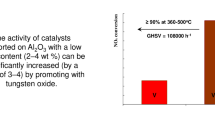Abstract
Regeneration of chlorine by oxidation of hydrogen chloride is an important problem in the production of chloroorganic products. The known catalysts for this reaction are insufficiently active and typically not stable enough, while data on the use of V catalysts for this process are absent. Here we report on our study of the stability and catalytic activity of the industrial sulfuric acid production sulfate-promoted vanadium catalyst IK-1-6 in the process of oxidation of hydrogen chloride with molecular oxygen. Under conditions of low conversion (less than 15%) with the reaction in the external diffusion region, the catalyst activity attained 660 g/(kg cat h) at 400°C, and the mass loss rate of the catalyst was (due to the formation of volatile vanadyl chloride) 4.6 % per hour, based on vanadium. Under high conversion conditions (over 60%), the vanadyl chloride formed in the top layer of the catalyst was hydrolyzed and precipitated on subsequent layers as the conversion of the reaction mixture increased, leading to a redistribution of vanadium over the catalyst bed height and hindering its removal form the reactor. The stable operation of the catalyst can be ensured by intermittently changing the flow direction of the reactant gas in the catalytic reactor or using an array of several reactors connected in series, intermittently changing their places in the inlet-outlet chain. Our results show that the industrial sulfate-promoted vanadium catalysts for the oxidation of sulfur dioxide are more active and stable than all known catalysts of the Deacon process (except for ruthenium catalysts) and could be used for catalytic oxidation of hydrogen chloride.
Similar content being viewed by others
References
Iwanaga, K., Seki, K., Hibi, T., et al., Sumitomo Kagaku, 2004, no 1, pp. 4–12.
Parfenov, O.G. and Pashkov, G.L., Problemy sovremennoi metallurgii titana (Problems in Modern Titanium Metallurgy), Novosibirsk: Izd. Sib. Otd. Ross. Akad. Nauk, 2008.
US Patent 3968050, 1976.
US Patent 4119705, 1978.
Mortensen, M., Minet, R.G., Tsotsis, T.T., and Benson, S.W., Chem. Eng. Sci., 1999, vol. 54, pp. 2131–2139.
Bostwick, L.E., Recovering Chlorine from HCl, Chem. Eng. Sci., 1976, no 10, p. 86.
US Patent 4774 070, 1988.
US Patent 5707919, 1998.
US Patent 5871707, 1999.
US Patent 6962682, 2005.
US Patent 4269817, 1981.
Feshchenko, L.V., Vlasenko, V.M., Chernobrivets, V.L, and Kurilets, Ya.P., Zh. Prikl. Khim., 1991, vol. 64, pp. 2040–2044.
Hisham, M.W.M. and Benson, S.W., J. Phys. Chem., 1995, vol. 99, pp. 6194–6198.
Fotiev, A.A., Slobodin, B.V., and Khodos, M.Ya., Vanadaty: Sostav, Sintez, Struktura, Svoistva (Vanadates: Composition, Synthesis, Structure, and Properties), Moscow: Nauka, 1988.
Kustov, A.D., Parfenov, O.G., Tarabanko, V.E., and Tarabanko, N.V., O retsiklinge khlora v subkhloridnoi metallurgii, in: Tsvetnye metally Sibiri 2009: Sb. dokladov pervogo mezhdunarodnogo kongressa (On Recycling of Chlorine in Subchloride Metallurgy, in: Nonferrous Metals of Siberia: Proceedings of the 1st Int. Congr.), Krasnoyarsk: OOO Verso, 2009.
Tarabanko, N.V., Tarabanko, V.E., and Koropachinskaya, N.V., A New Vanadium Catalyst for Chlorine Production by Hydrogen Chloride Oxidation, Abstracts: EuropaCat IX, 2009, p. 256.
Tarabanko, V.E., Tarabanko, N.V., Zhyzhaev, A.M., and Koropachinskaya, N.V., J. Sib. Federal Univ., Chemistry, 2009, no 2, pp. 11–18.
Tarabanko, N.V. and Tarabanko, V.E., J. Sib. Fed. Univ. Chem., 2009, no 2, pp. 219–222.
Muzgin, V.N., Khaledina, L.B., Zolotavin, V.L., and Bezrukov, I.Ya., Analiticheskaya khimiya vanadiya (Analytical Chemistry of Vanadium), Moscow: Nauka, 1981.
Ioffe, I.L. and Pis’men, L.M., Inzhenernaya khimiya geterogennogo kataliza (Engineering Chemistry of Heterogeneous Catalysis), Moscow: Khimiya, 1972.
Boreskov, G.K., Kataliz. Voprosy teorii i praktiki (Catalysis: Theory and Practice), Novosibirsk: Nauka, Sib. Otd., 1987.
Kratkii spravochnik fiziko-khimicheskikh velichin (A Concise Handbook of Physicochemical Quantities) Ravdel’, A.A. and Ponomareva, A.M., Eds., Leningrad: Khimiya, 1983.
Kuchling, H., Physik, Leipzig: Fachbuchverlag, 1980.
Spravochnik mashinostroitelya v shesti tomakh (Machine Builder’s Handbook in Six Volumes), Acherkan, T., Ed., vol. 2, Moscow: GNTI Izd. Mashinostroitel’noi Literatury, 1960.
Levina, L.M., Strots, V.O., Popov, S.A., and Matros, Yu.Sh., React. Kinet. Catal. Lett., 1990, vol. 42, pp. 73–78.
Boreskov, G.K, Matros, Yu.Sh., Menyailov, N.N., et al., Khim. Prom-st’, 1985, no 1, pp. 35–37.
Author information
Authors and Affiliations
Corresponding author
Additional information
Original Russian Text © V.E. Tarabanko, N.V. Tarabanko, N.V. Koropachinskaya, 2010, published in Kataliz v Promyshlennosti.
Rights and permissions
About this article
Cite this article
Tarabanko, V.E., Tarabanko, N.V. & Koropachinskaya, N.V. Using vanadium catalysts for the oxidation of hydrogen chloride with molecular oxygen. Catal. Ind. 2, 259–265 (2010). https://doi.org/10.1134/S2070050410030098
Received:
Published:
Issue Date:
DOI: https://doi.org/10.1134/S2070050410030098




